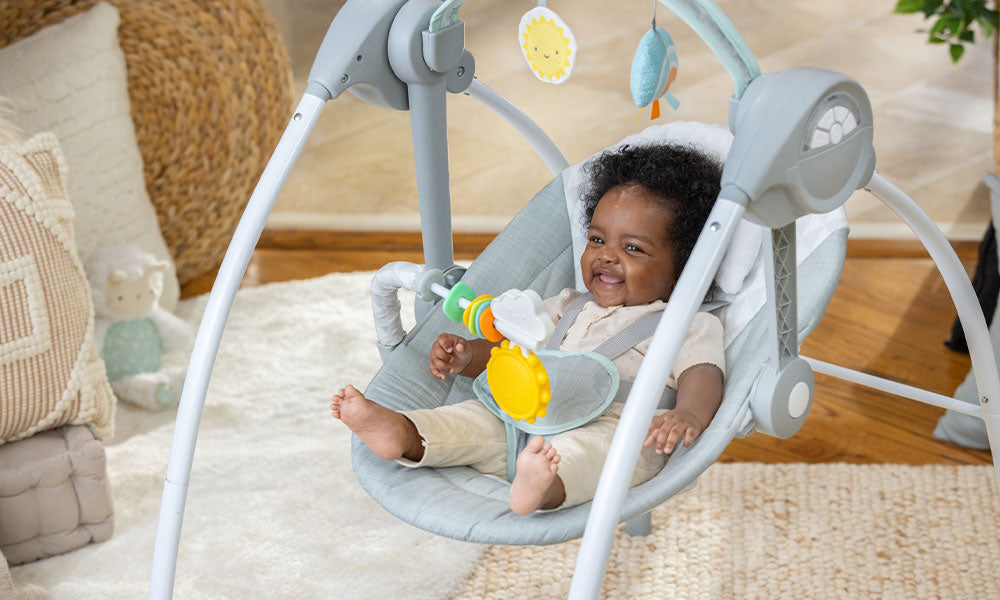Wake windows are simply the stretch of time baby is awake between naps. We’re going to show you how they can be a tool for smoother days and longer stretches of sleep (hooray!).
For me, discovering wake windows was an aha moment as a new parent. They helped me build both structure and flexibility into my routine and empowered me to create a schedule that worked for the whole family. Before I understood the concept of wake windows, I remember googling a schedule that included baby waking up for the day at 7 AM. But what was I supposed to do when my daughter Simone cried and cried at 5:30 AM, and I decided to turn on the coffee machine and start my day, and hers? I didn’t know how to juggle the weird timing of baby life.
Wake windows to the rescue. Instead of a blanket statement that baby had to go down for a nap at, say, 10 AM, they gave a general guideline based on the length of tine baby had been up and at ‘em.
Wake Windows 101
These are a starting point, not set-in-stone rules:
- 1 to 2 Months: 1 to 2 Hours
- 3 to 4 Months: 75 Minutes to 2.5 Hours
- 5 to 7 Months: 2 to 4 Hours
- 8 to 10 Months: 2.5 to 4.5 Hours
- 11 to 14 Months: 3 to 5 Hours
- 15 to 24 Months: 4 to 6 Hours
Wake windows include everything that happens while your baby or toddler is out of the bassinet or crib, living their best baby life. That includes feeding, playing with toys, heading outside for a stroller walk, singing songs, reading books, and even getting ready for bed.
Set up your wake windows for success by making sure baby gets plenty of play and stimulation. My family loved the Ingenuity Sun Valley Milestone Swing when our kids were babies— it features two grow-with-me toy bars, stimulating toys for baby to engage with and reach toward.
Adjust as you go. For example, if your baby takes a mini snooze (less than an hour), then their next wake window will shrink. On the other hand, if baby takes an extra-long sojourn, their next wake window should be longer. On travel days or for special events, the routine will get messed up, and that’s ok—it’s just part of life, and you will find your rhythm again soon. Helpful hint: gradually extending wake windows as the baby grows older is a natural progression, so you shouldn’t have to work too hard to achieve this.
Wake Windows Can Encourage Drifting Off
Babies’ sleeping patterns are constantly changing, especially the first year, and wake windows can help navigate getting them the rest their growing brains and bodies need. Babies, infants, and toddlers have different sleeping patterns and varying sleep needs, which is why these are general guideposts, not hard and fast rules.
You probably know what your baby looks like when they’re exhausted. As the wake window comes to an end, start to tune into their cues. Maybe they stare off into space or rub their eyes. Perhaps they just seem grumpy and touchy. Once they show visible signs of tiredness, like yawning and crying, the guessing game is officially over.
It’s time to start the naptime or bedtime routine right away—do not delay, do not pass go. In other words, don’t just pay attention to the clock—watch your baby.
If you get the wake window right, it means they’re going to bed in a sweet spot where they are tired but not overtired—which weirdly makes it even harder for little ones to get to sleep (my manic post-bedtime toddler screaming and tearing through my house is excellent proof of this).
Wake Windows Can Help Baby Sleep for Longer Stretches
Sleep pressure, or our natural drive to sleep, has the biggest influence on naptime, and the right wake windows let baby build up an ideal sleep pressure for sustained zzzs. Being as consistent as possible with your baby's age-appropriate wake windows will help stabilize sleep pressure to create a solid stretch of essential sleep. Having that dependable rhythm will also make life easier for caregivers. Three cheers to that.
Regular sleep is crucial both for baby’s healthy development and for reducing parental stress—a foundation for a joyful childhood and parenthood. Remember, wake windows are not a cure-all. They’re just one (valuable!) piece of the overall sleep puzzle, alongside sleep environment, sleep routine, attachment, and pretty much all the parts of your baby’s life.
We hope wake windows can be a useful tool in your toolbox for successful sleep for the whole family. They certainly are for us.



